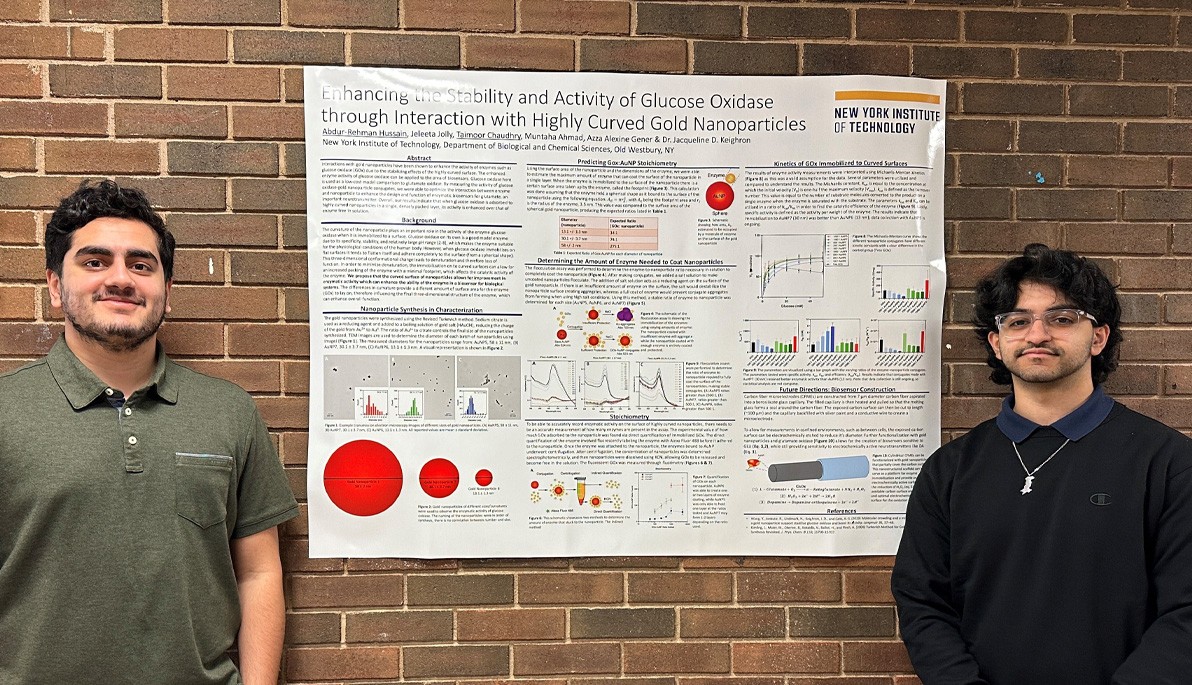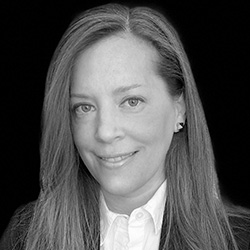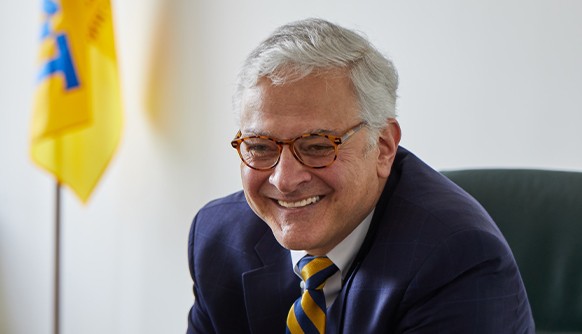News
Students Achieve Second Place Win at Biology Conference
January 4, 2024
Pictured: Abdur-Rehman Hussain, left, and Taimoor Chaudhry received second place for their poster presentation in the biochemistry, biophysics, and biotechnology division at the 56th annual Metropolitan Association of College and University Biologists Conference.
Two students on the research team of Assistant Professor of Biological and Chemical Sciences Jacqueline Keighron, Ph.D., presented their work at the 56th annual Metropolitan Association of College and University Biologists Conference, held at the University of Bridgeport in Connecticut in November. Biology majors Taimoor Chaudhry and Abdur-Rehman Hussain came in second place for their poster presentation in the biochemistry, biophysics, and biotechnology division.
Chaudhry and Hussain are assisting Keighron, who is working on biosensors (an analytical device that utilizes biomolecules to detect chemical compounds) that use enzymes to turn chemical signals into electrical signals that can be detected on an electrode that is small enough to wedge into the microscopic space of synapses (points of contact between neurons where information is passed from one neuron to the next). The research is still in progress, but Keighron hopes to develop a tool that can better understand how neurons communicate with each other and how those messages change when the neuron is exposed to new substances or has a disease state.
By using a biosensor, researchers can detect the release of a neurotransmitter in real time. This allows researchers to monitor the interactions between neurons and the signal changes that arise from neurological disorders such as depression, substance abuse, Parkinson’s disease, or Alzheimer’s disease. These chemical messages can be complex and involve the signaling of multiple neurotransmitters at the same time.
The signals Keighron and her team are focused on are glutamate and GABA (gamma-aminobutyric acid), two neurotransmitters that have opposite actions but are often found in similar places. Glutamate regulates brain function. GABA is a chemical messenger that slows down the brain by blocking specific signals in the central nervous system, creating a calming effect.
Their work expands upon research on chemical signals that are easier to measure, like dopamine and serotonin. Studying dopamine and serotonin has provided information on the mechanism of action of drugs like cocaine and medications used to treat depression and similar disorders, as well as how psychiatric disorders affect the brain. The biosensor for glutamate and GABA that Keighron is working on will provide similar information to help further understand these states and aid researchers in designing the next generations of medicines and techniques to treat a wide variety of disorders, including Parkinson’s disease, Alzheimer’s disease, and Huntington’s disease.
Chaudhry and Hussain sat down with New York Tech News to talk about the study and their experience presenting at the conference.
Can you talk about the poster you presented?
Taimoor Chaudhry (TC): The focus of our poster was to measure the activity of enzymes when combined with gold nanoparticles. We found that enzymes reacted with better efficiency when bound to the surface of the gold nanoparticles. The spherical nature of the conjugate helps the enzyme retain its shape, allowing for continued function and higher efficiency.
Abdur-Rehman Hussain (AH): We found that by binding enzymes to a spherical gold nanoparticle, we were able to make an enzyme more stable and produce an increase in activity. We were able to improve the function of enzymes by preventing any disruption to their structure. This was a great finding because now we know we can create stable “bioconjugates” that canbe placed at the tip of an electrode to detect neurotransmitter activity.
What were your roles in the study?
TC: My responsibilities were to help create the electrodes that will be used to detect activity. My task was to learn how to build the electrodes and prepare them for testing, which is an ongoing process and the future direction of our project.
AH: I worked with certain enzymes and performed assays that looked at enzyme activity kinetics. Observing how combining enzymes with gold nanoparticles affected enzyme activity allowed us to understand how to use these enzymes on the electrodes that Taimoor has been working on to create a functioning sensor.
What do your findings mean in terms of next steps?
AH: From this point, we are attempting to use enzymes that directly interact with target neurotransmitters to see if we can obtain similar results by creating new enzyme conjugates. Our ultimate goal is to be able to combine our research on enzyme conjugates with the research on electrodes to create a functioning biosensor.
How close are you to achieving your goal?
AH: At the moment, we still have a way to go. I would say we have accomplished an important step with our research so far, but we have to continue working on perfecting our enzyme conjugate assays and creating electrodes before we begin moving farther into the project.
Congratulations on your poster winning second place in the biochemistry, biophysics, and biotechnology (BBB) division. What was the experience like?
TC: The BBB division was the largest of the categories at the conference, so winning second place was a welcomed surprise. But looking back, it felt nice to be rewarded for our efforts throughout the semester.
AH: As Taimoor mentioned, winning even second place in one of the largest categories was an amazing feeling of accomplishment, considering how much time and effort we have put into our project thus far.
Was this your first time presenting at a conference? What was the experience like?
TC: This was my first research conference, so it was very exciting and nerve-racking. Although we practiced presenting our poster beforehand, I was still worried about messing up. But once we got settled in, I was more relaxed and confident. During the award ceremony, I was not expecting any sort of award, but when our poster was named for second place, I was very happy and excited. No nerves in sight.
AH: This was my second time presenting at a conference, with my first time being at New York Tech’s SOURCE [Symposium of University Research and Creative Expression]. Because I already had some experience, I was more prepared for this conference. However, I was still nervous because this time around, I wasn’t presenting to my professors at school. It was just as Taimoor said. Once we started presenting to the judges, I became more relaxed and was able to answer questions with confidence.
How will experiences like this help you in your future career?
TC: Having firsthand experience working in a research lab and attending conferences allows us to develop our technical and networking abilities. In the lab, we become familiar with how to run experiments, to work with others, and use our knowledge to further scientific discoveries. At conferences, we develop connections with fellow scientists, learn to present our findings and communicate with everyone to better understand the research we do. These skills transfer over to a professional lab setting but can transfer to the healthcare field as well.
What attracted you to this research?
TC: When I took Biochemistry, I enjoyed the lab portion of the course. We worked on various experiments to develop and learn different lab techniques. When beginning research under Dr. Keighron, I was able to practice and master those lab techniques. But what I enjoyed most was learning various new techniques, such as building electrodes, creating conjugates, and collecting data using different programs. I continue to learn new steps and techniques that I will be able to use when continuing my research endeavors in the future.
AH: I enjoyed learning about biochemical assays and putting what I learned in class into practice, and I wanted to learn more about research applications. I asked Dr. Keighron about her current research, and she explained how she has been working with developing advanced biosensors that are used for detecting neurotransmitter activity.
What are your career goals?
TC: After I graduate, I plan to work at a research laboratory until I gain admission to medical school.
AH: After I graduate, I plan to attend medical school and become a physician.
How will this research help you achieve your career goals?
TC: The skills and experiences I have gained in Dr. Keighron’s research lab will help me when working in more advanced lab settings or with research in the medical field.
AH: I think that taking a heavy subject such as biochemistry and really reinforcing that knowledge with extensive research while learning laboratory techniques made me a more well-rounded student and gave me a much better understanding of how biochemical sciences can be applied to the medical field.
This interview has been edited and condensed.





